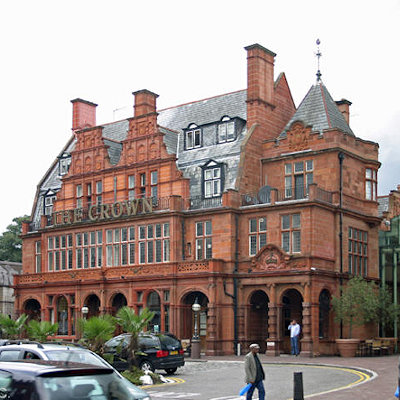
Like us on Facebook
PLACE NAMES


 
|
|
Cricklewood
|

|
|
|
Cricklewood is an urban and suburban area of north-west London, England, centred 5 miles (8.2 km) northwest of Charing Cross, between Willesden Green and Dollis Hill to the west, Brondesbury and Kilburn to the south, West Hampstead and Childs Hill to the south-east and east, and Brent Cross to the north. The area is split between three London boroughs: Barnet to the north-east, Brent to the west and Camden to the south-east.
Cricklewood was a small rural settlement, in parish terms a hamlet, around Edgware Road, originally the Roman road which was later called Watling Street, until the impetus for its urbanisation came with the surface and underground railways in nearby Willesden Green in the 1870s. The bustling shops on Cricklewood Broadway, as Edgware Road is known here, contrast with quieter surrounding streets of largely late-Victorian, Edwardian, and 1930s housing. The area has strong links with Ireland due to a sizeable Irish population. The Crown pub, now the Crown Moran Hotel, is a local landmark. The 35-hectare (86-acre) Gladstone Park marks its north-western edge.
Cricklewood has two conservation areas, the Mapesbury Estate and the Cricklewood Railway Terraces, and in 2012 was awarded £1.65 million from the Mayor of London's office to improve the area.
There was a small settlement at the junction of Cricklewood Lane and the Edgware Road by 1294, which by 1321 was called Cricklewood. By the 1750s the Crown (rebuilt in 1889) was providing for coach travellers, and by the 1800s it had a handful of cottages and Cricklewood House as neighbours, and was known for its "pleasure gardens". By the 1860s there were a number of substantial villas along the Edgware Road starting with Rockhall Lodge.
The Mapesbury Dell on Hoveden Road is an award-winning small park and garden administered by local residents. It started in 2000 when local residents in conjunction with the Mapesbury Residents Association decided that their local green space was too valuable to leave to fortune. The dell is open to the public during daylight hours and is used throughout the year, for example hosting carol services in mid-December.
Gladstone Park marks the north-western edge, covering approximately 35 hectares (86 acres). In 2003-04, Gladstone Park features and facilities were improved/restored with the aid of Heritage Lottery funding. The park contains a well maintained formal garden, children's playground, art gallery, cafe and pond, as well as good sport facilities (football/rugby/cricket pitches and tennis and netball courts). Barring fog and rain its peak gives good views of Wembley Stadium, the London Eye and the Shard. The park was frequented by Mark Twain around the turn of the 20th century whilst staying in accompanying Dollis Hill House, about which altogether he said he had "never seen any place that was so satisfactorily situated, with its noble trees and stretch of country, and everything that went to make life delightful, and all within a biscuit's throw of the metropolis of the world".
The historic Crown pub is a terracotta, grade two listed Victorian building on Cricklewood Broadway, built by the architects Shoebridge & Rising in 1899. It was fully restored in 2003, and reopened as the Crown Moran Hotel and with the addition of a 152-room 4 star hotel and restaurant (Kitchen at the Crown). The building style has been described as: "Free Flemish Renaissance, with two stepped and voluted gables in front of a slate mansard roof, a battlement turret at one end. Plentiful terracotta ornament; four handsome cast-iron lamp standards in front."
Another notable local building is the Cricklewood Baptist Church on Anson Road at the Junction with Sneyd Road. The church was built in 1907 of red and yellow brick in the Italian Byzantine style. Other local churches include St Gabriel's Church on Walm Lane; Claremont Free Church on Cheviot Gardens/Claremont Road built in 1931; and St. Agnes' Roman Catholic Church built in 1883 on Cricklewood Lane. St. Agnes' Catholic Primary school is next door and both cater for the large Catholic population of the area.
Cricklewood Pumping Station built in 1905 is another distinctive building, the interior of which was used as a double for the Titanic's engine rooms of the 1997 film, Titanic.
|
 Feel free to Email me any additions or corrections Feel free to Email me any additions or corrections
LINKS AVAILABLE TO YOUR SITE
| |





